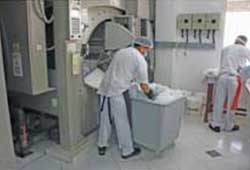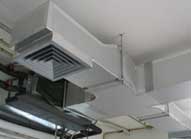
Hospital Laundry Water Treatment
• Textile suppliers to hospitals and hospital laundries face great pressures to meet high standards of hygiene, quality, logistics, cost optimization and transparency.
• Textiles must be handled correctly to limit the transfer of dangerous bacteria amongst patients and healthcare staff and the right wash processes are vital for the desired result.
• As pressure grows on hospitals to cut costs, healthcare administrators are weighing the cost of outsourcing their linen services to textile rental companies against the cost-effectiveness of operating an on-premise laundry (OPL).
• A bad linen service is one of the most frequently heard complaints in a hospital. Attention to patients' personal needs and comforts are as important as the physician's medication and therefore adequate supply of clean linen becomes imperative. Besides helping in maintaining a clean environment, clean linen is a vital element in providing high-quality medical care. Also, pleasant employees in a fresh and neat uniform go a long way in creating a positive image of the hospital.
• The prevention of microbiological contamination is the most significant requirement for the hygienic processing of textiles.
• Hospital bed sheets, gowns, uniforms, towels and cleaning mops are potential tools for spreading infections.
• Properly controlled laundry processes can limit the spread of bacteria. Good practices start with appropriate washing techniques that will ensure decontamination of linen.
• The use of ozone in the laundry water reduces the requirement of detergents and also the wash can be achieved with lower temperatures.
Hospital Drinking Water Treatment:
• The Hospital Water Supply as a Source of Nosocomial Infections.
• Some of the most frequently isolated gram-negative bacteria, including Pseudomonas and Enterobacter, have been found to persist in hospital water for extended periods and have been responsible for nosocominal outbreaks.
• Contamination of the hospital water supply with potentially pathogenic organisms is very common
• Impurities in potable water cases health disorders. In the hospitals patients generally take the drinking water directly from the supplies provided by the public health engineering. If this water becomes contaminated, the patient may suffer from some water borne disease.
• The drinking water distribution system of a hospital mainly obtained Legionella and Pseudomonas aeruginosa Moreover, several other opportunistic pathogenic bacteria, such as Escherichia albertii, Acinetobacter lwoffi and Corynebacterium tuberculostrearicum emphasizing that drinking water systems, especially those with stagnant water sections, could be the source of nosocomial infections.
• Ozone is both a strong oxidizing agent as well as a strong disinfectant
• Ozone interferes with the metabolism of bacterium cells most likely through inhibiting and blocking the operation of the enzymatic control system.
• A sufficient amount of ozone breaks through the cell membrane, and this leads to the destruction of the bacteria.
• Ozone destroys viruses by diffusing through the protein coat into nucleic acid core, resulting in damage of the viral RNA.

Hospital Healthcare HVAC System: -
. Ozone has been successfully reduced smell, bacteria, mould, mildew and other mi.cro organisms from the HVAC system. Ozone is increasingly being used in HVAC system to improve the indoor air quality and also to improve the energy efficiency of the HVAC cooling coils.
. Controlled quantity of ozone introduces in the AC Ducts Eliminates Toxic gasses, odors smoke by oxidation and microbes & virus.
Hospital Operation Theatre Fumigation with Ozonation:-
. It is very important to maintain good indoor air quality (IAQ) in hospital Operation theatre to ensure health and safety for the patient and surgical team. A significant consideration in Operation Theatre is the control of aerosols, anesthesia gases and smoke. Aerosols are solid and liquid particles
. It is very important to maintain good indoor air quality (IAQ) in Operation Theatre to ensure health and safety for the patient and surgical team.
. A significant consideration in Operation Theatre is the control of aerosols, anesthesia gases and smoke. In Operation Theatre, however the main sources have an indoor origin are the patient, the surgical team and equipment. The anesthesia gases dispersed in ORs are also considered as pollutants. The anesthesia gases are dispersed in the environment through problems in the equipment and from the exhalations of the patient. Some gases used in the surgery, for example, NO2 will continue to be exhaled by the patient for up to one hour after the surgery is finished. During surgery the highest concentration of gases is on the floor. However, with the movements of people these gases can be mixed with room air and inhaled by the surgical team.
. The concentration of gases in the Operation Theatre is critical and needs to be controlled; otherwise the productivity and quality of the work of the surgical team can decrease, and in the medium and long term health problems may occur.
. Halothane gas, for example, has a high toxicity and can affect the central nervous system. The gas concentration is controlled by the air change rate in the Operation Theatre by dilution to acceptable levels.
. The smoke can be generated by laser or electro surgery unit. "Research studies have confirmed that this smoke plume can contain toxic gases and vapours such as benzene, hydrogen cyanide, and Formaldehyde, bioaerosols, dead and live cellular material (including blood fragments), and viruses. At high concentrations the smoke causes ocular and upper respiratory tract irritation in health care personnel, and creates visual problems for the surgeon.
. In some critical situations the indoor air in Operation Theatre will be ultra-cleaned, for example, for orthopedic surgery, traumas, implants
. burn patients, and other situations where the patient isimmuno compromised. Otherwise, when the surgery is septic, there should be also a higher control in the indoor environment, to protect the adjacent areas.
. In Operation Theatre Air Conditioner duct system instilled.
. AHU Ozone generators the released ozone combines with the mainstream air in the supply air duct and reaches the space. It is present in the indoor space at the times at low concentration. When it encounters chemical pollutants, it almost instantly oxidize them and keeps the indoor air free of chemical pollutants VOC as interferes with metabolism of cell multiplication of fungi resulting in the reduction of fungi along which is responsible for vide range of indoor related allergies.
Hospital Cooling Tower Water Treatment : -
. Cooling tower water requires extensive treatment. During Cooling Tower water treatment, three main factors must be controlled.
. Corrosion of pipes and heat exchanger units.
. Scaling in pipes and (mainly) in heat exchangers.
. Microbial growth (bacteria algae).
. These three aspects cannot be viewed separately. Conventional treatment techniques are mainly applications of chemical biocides, corrosion inhibitors and scale inhibitors. Ozone is a reliable alternative that controls the above-mentioned factors sufficiently.
. Makes the water crystal clear, eliminating all turbidity.
. Dissolves the scale and inhibits further scaling, hence improving heat transfer and further saving on chemicals and pollution.
. Reduced Chemical Usage - Chlorine can substitute for several chemicals in a cooling tower treatment package, reducing and possibly eliminating the use of such chemicals.
. Increases dramatically Heat Transfer Efficiency.
Sustainable Sewage Treatment Plant for Hospitals: -
. The Healthcare industry uses an exorbitant amount of water.
. More water is wasted because of appliances on and being careless with water usage. The hospitals ultimately pose a large threat to the environment, and alternate water and energy conservation methods are needed to combat this problem.
. Recycling has also been instituted to reduce pollution and reduce waste material.
. Waste water consists of black water and gray water. Black water, which is water contaminated by sewage, comes from your toilet. Grey water is wastewater generated from domestic activities such as laundry, dishwashing, and bathing which can be recycled on-site for uses such as landscape irrigation and constructed wetlands.
. Ozone black/grey water treatment is a method that is increasing in popularity. An ozone generator is used to break down pollutants in the water source.
. Using ozone to treat black/grey water has many benefits:
. Kills bacteria effectively.
. There are no nasty odors or residues produced from the treatment.
. Ozone converts back into oxygen quickly, and leaves no trace once it has been used.
. No harmful by products.
. Extremely effective disinfection.
. No sludge formation.

Head Office: 28, Satyam Industrial Estate, Subhash Road, Jogeshwari (East), Mumbai, Maharashtra 400060